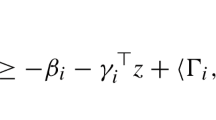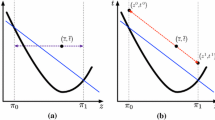Abstract
Recently a new, geometrically motivated approach was proposed [1] for integer programming, based on generating intersection cuts from some convex setS whose interior contains the linear programming optimum\(\bar x\) but no feasible integer point. Larger sets tend to produce stronger cuts, and in this paper convex analysis is used to construct sets as large as possible within the above requirements. Information is generated from all problem constraints within a unit cubeK containing\(\bar x\) The key concept is that of outer polars, viewed as maximal convex extensions of the ballB circumscribingK, relative to the problem constraints. The outer polarF * of the feasible setF overB is shown to be a convex set whose boundary contains all feasible vertices ofK, and whose interior contains no feasible integer point. The existence of a dual correspondence betweenF andF *, and the fact that polarity is inclusion-reversing, leads to a dualization of operations onF. As one possible procedure based on this approach, we construct a generalized intersection cut, that can be strengthened whenever some vertex ofF is cut off. This makes it possible to fruitfully combine intersection cuts with implicit enumeration or branch-and-bound. While valid for arbitrary integer programs, the theory developed here is relevant primarily to (pure or mixed-integer) 0–1 problems. Other topics discussed include: generalized polars, intersection cuts from related problems, connections with asymptotic theory.
Similar content being viewed by others
References
E. Balas, “Intersection cuts — a new type of cutting planes for integer programming,” Management Sciences Research Report No. 187, October 1969,Operations Research 19 (1971) 19–39.
E. Balas, “Alternative strategies for using intersection cuts in integer programming,” Management Sciences Research Report No. 209, Carnegie—Mellon University, June 1970.
E. Balas, “Integer programming and convex analysis,” Management Sciences Research Report No. 246, Carnegie—Mellon University, April 1971.
E. Balas, “A note on the asymptotic theory of integer programming and the 0–1 case,” Management Sciences Research Report No. 249, Carnegie—Mellon University, May 1971.
E. Balas, “Ranking the facets of the octahedron,” Management Sciences Research Report No. 252, Carnegie—Mellon University, May 1971.Discrete Mathematics 2, No.1 (1972) 1–15.
E. Balas, “Implicit enumeration with intersection cuts from outer polars,” NATO Conference on the Application of Optimization Methods to Large-Scale Systems.” Elsinore (Denmark), July 5–9, 1971.
E. Balas and C. Burdet, “On concave quadratic programming,” in preparation.
E. Balas and R. Jeroslow, “Canonical cuts on the unit hypercube,” Management Sciences Research Report No. 198. Carnegie—Mellon University, Aug.–Dec. 1969.SIAM Journal on Applied Mathematics 23 (1972) No. 1.
E. Balas, V.J. Bowman, F. Glover and D. Sommer, “An intersection cut from the dual of the unit hypercube,”Operations Research 19, No. 1 (1971) 40–44.
C. Burdet, “A class of cuts and related algorithms in integer programming,” Management Sciences Research Report No. 220, Carnegie—Mellon University, September 1970.
C. Burdet, “Enumerative inequalities in integer programming,”Mathematical Programming 2 (1972) 32–64.
F. Glover, “Convexity cuts,” University of Texas, Austin, December 1969.
F. Glover, “Cut-search methods in integer programming,” University of Colorado, September 1970.
R. Gomory, “On the relation between integer and noninteger solutions to linear programs,”Proceedings of the National Academy of Sciences 53 (1965) 260–265.
R. Gomory, “Some polyhedra connected with combinatorial problems,”Linear Algebra and its Applications 2 (1969) 451–558.
B. Grunbaum,Convex polytopes (Wiley, New York, 1967).
Hoang Tuy, “Concave programming under linear constraints,”Doklady Akademii Nauk SSSR (1964) (in Russian); English translation:Soviet Mathematics (1964) 1437–1440.
M. Raghavachari, “On the zero–one integer programming problem,” Technical Report No. 20, Department of Statistics, Carnegie—Mellon University, July 1968,Operations Research 17 (1969) 680–684.
R.T. Rockafellar,Convex analysis (Princeton University Press, Princeton, 1970).
J. Shapiro, “Dynamic programming algorithms for the integer programming problem I. The integer programming problem viewed as a Knapsack problem,”Operations Research 16 (1968) 103–121.
J. Stoer and C. Witzgall,Convexity and optimization in finite dimensions I. (Springer, Heidelberg, 1970).
A.D. Yoffe and V.M. Tikhomirov, “Duality of convex functions and extremum problems,”Uspekhi Matematicheskih Nauk 23, No. 6 (1968) 51–116; English translation:Russian Mathematical Surveys (1968) 53–124.
R.D. Young, “New cuts for a special class of 0–1 integer programs,” Rice University, October 1968.
Author information
Authors and Affiliations
Additional information
The research underlying this paper was partially supported by the National Science Foundation under grant GP-31699 and by the Office of Naval Research under contract N00014-67-A-0314-0007 NR 047-048.
Rights and permissions
About this article
Cite this article
Balas, E. Integer programming and convex analysis: Intersection cuts from outer polars. Mathematical Programming 2, 330–382 (1972). https://doi.org/10.1007/BF01584553
Received:
Revised:
Issue Date:
DOI: https://doi.org/10.1007/BF01584553




